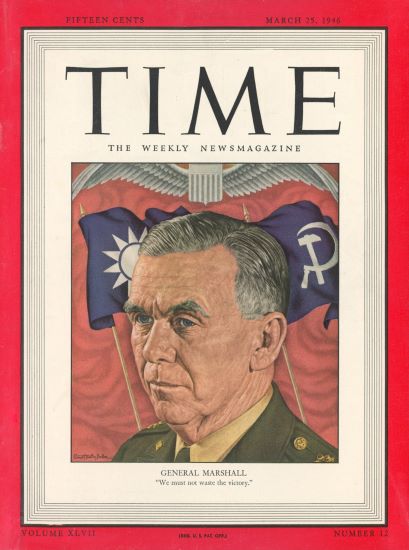 On a wintry evening in December 1945, the telephone at Dodona Manor rang for General Marshall. It was President Harry S. Truman who, just ten days after Marshall retired as Army Chief of Staff, requested that Marshall serve as U.S. Special Envoy to China. Ever the public servant, Marshall accepted his next call to duty.
On a wintry evening in December 1945, the telephone at Dodona Manor rang for General Marshall. It was President Harry S. Truman who, just ten days after Marshall retired as Army Chief of Staff, requested that Marshall serve as U.S. Special Envoy to China. Ever the public servant, Marshall accepted his next call to duty.
General Marshall acted as peacemaker between the warring Kuomintang government under Generalissimo Chiang Kai-shek and the Communist Party of China under Mao Zedong. Since the Second Sino-Japanese War (1939-1945), the Chinese Communists (CCP) and Chinese Nationalists (KMT) had engaged in an uneasy stalemate that quickly faltered back and forth into a Chinese Civil War.
During World War II, the U.S. Army sent General Joseph Stilwell to support the temporarily unified armies of Mao and Chiang against the Japanese. However, distrust between the two proud military leaders forced President Franklin Roosevelt to intervene and order General Patrick Hurley to act as Special Envoy and middleman. Both the CCP and KMT accused each other of withholding arms and soldiers against the Japanese in preparation for a war with each other. In a last-ditch attempt to unify the country, President Harry Truman sent his best unifier to China as Special Envoy: General George Marshall.
Marshall arrived in China on December 20, 1945, replacing Ambassador Hurley. Hoping a Nationalist China would protect against Soviet encroachment, negotiations between the CCP and KMT began immediately. Although little progress was made, the Chinese people were in favor of Marshall’s arrival. On March 26, 1946, Time Magazine printed George Marshall on their cover for the fourth time. Ernest Hamlin Baker’s depiction of Marshall showed him backed by the flags of the Nationalist and Communist parties. A winged shield symbolizing the United States flies above. Time’s article documented the General’s work, saying “He was direct, straightforward, unfailingly polite. Soon his visitors referred to him as ‘The Old Professor,’ a token of esteem in China, where the scholar still ranks above the other three classes (farmers, artisans and merchants) of society.”
Chiang Kai-shek and Mao Zedong were less amiable than America’s magazine. Tensions continued to rise into 1946. Marshall ceased the U.S. sale of weapons to the Nationalists between July 29, 1946 and May 1947 in an effort to broker a ceasefire. Finally, after 300 meetings and with corruption running rampant between both Chinese leaders, Marshall left China in January 1947. He would return to retirement for nearly another ten days until his appointment as Secretary of State.
Cody Youngblood is a graduate student and docent at George C. Marshall’s Dodona Manor in Leesburg, Virginia. Follow his adventures @young_preservationist.
